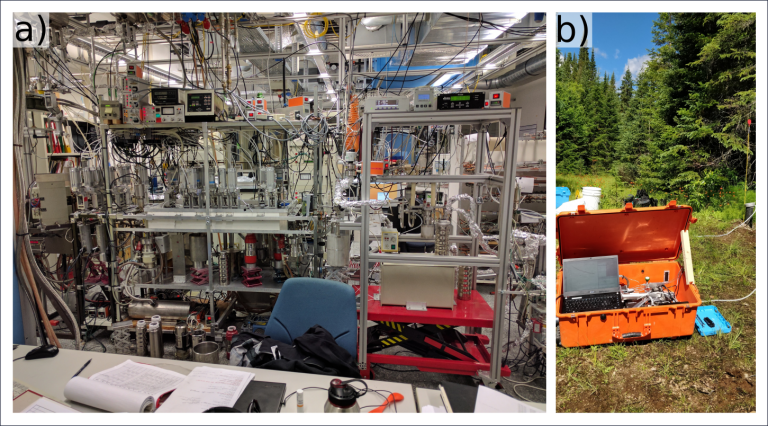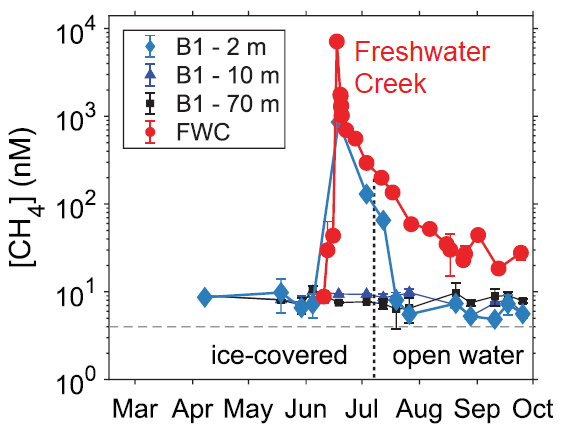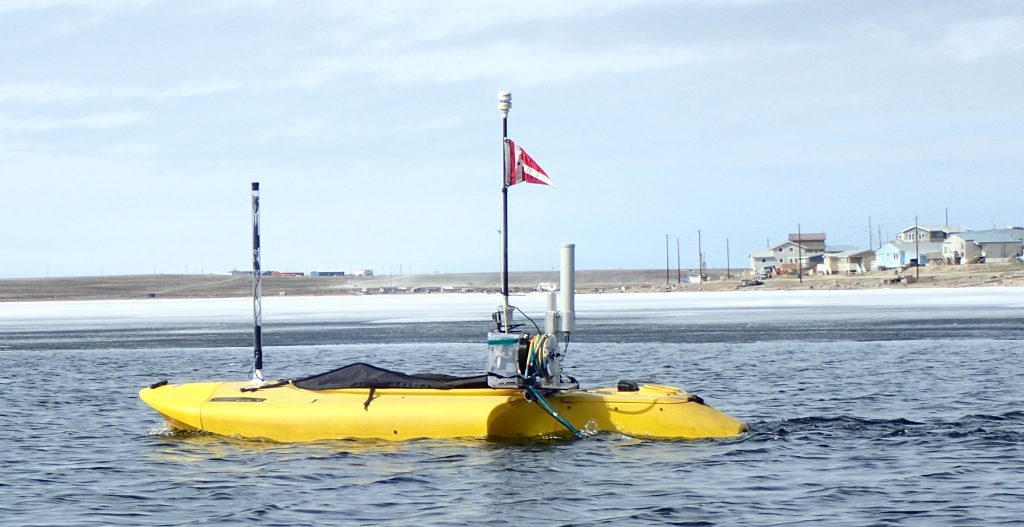Research

Quantifying biological productivity
A major focus of the research group is on quantifying biological productivity in marine, estuarine, and freshwater systems using techniques ranging from in situ gas tracer measurements to bottle incubations.
As part of her PhD research, Cara published papers applying oxygen/argon and triple oxygen isotope measurements to quantify net community production and gross primary production in ice-covered waters (Manning et al., 2019) and comparing incubation-based and gas tracer-based methods of quantifying productivity in a coastal upwelling zone (Manning et al., 2017, JGR). She also developed a new method for accurately quantifying gross productivity using the triple oxygen isotope method in waters with freshwater influence (Manning et al., 2017, GRL).
During her postdoc, she was involved in research pairing dissolved oxygen measurements with nitrous oxide and nitrogen to improve estimates of net community production (Izett et al., 2018, Izett et al., 2021).
At UConn, we will be setting up mobile and high-throughput methods for measuring oxygen/argon and oxygen/nitrogen ratios, as well as nitrous oxide. These methods will enable high-resolution measurements of productivity in dynamic systems such as coastal waters.
Greenhouse gas cycling
Funded project:
NSF award 2241432, “Exploring the dynamics of nitrous oxide in the Southern Benguela Upwelling System”
Another focus of the research group is on the biogeochemical cycles of greenhouse gases whose concentrations are increasing due to human activities, particularly carbon dioxide, methane, and nitrous oxide.
Cara’s past research has included studying the seasonality of methane emissions in Cambridge Bay, Nunavut using a community-based monitoring program and novel mobile methods (Manning et al., 2020), and characterizing interannual variability in methane and nitrous oxide distributions across the North American Arctic Ocean (Manning et al., 2021).
She also conducted research on the environmental impacts of oil and gas production by participating in a controlled injection experiment in which a synthetic natural gas was injected into an aquifer in northeast British Columbia, Canada (Cahill et al., 2019).
At UConn, we are setting up methods to make precise and accurate continuous and discrete measurements of nitrous oxide, methane, and carbon dioxide. We will develop software for data acquisition and processing. We will also develop laboratory infrastructure to test and calibrate this instrumentation.
Research topics we plan to investigate include the rates of and controls on sea-air fluxes of greenhouse gases, and the controls on the nitrous oxide yield of nitrification and denitrification.
We also plan to collect high-resolution datasets of nitrous oixide, methane, and carbon dioxide to better characterize their sources and sinks in a variety of ecosystems.
Noble gas tracers of environmental processes
Noble gases are useful tracers of physical processes in the environment because they are biologically and chemically inert. Measurements of multiple noble gases spanning a range of physical and chemical properties (e.g., solubility and molecular diffusivity) can be used to parameterize physical processes and separate biological from physical fluxes for gases such as oxygen. During Cara’s PhD, she developed a mobile method for continuous measurements of dissolved Ne, Ar, Kr, and Xe ratios (Manning et al., 2016, Analytical Chemistry) and applied measurements of multiple noble gases to quantify air-sea gas exchange in the coastal ocean (Manning et al., 2016, IOP Conf. Ser.).
Cara has also coauthored papers using continuous measurements of N2 and three noble gases (He, Ar, and Kr) to quantify excess N2 from denitrification (Popp et al., 2020) and describing the rapid research advances enabled by mobile mass spectrometry (Popp et al., 2021).
At UConn, we are planning to develop and apply new, high-throughput mass spectrometry-based methods to measure noble gases and N2 in water and sediments, and use the data to quantify denitrification and nitrogen fixation rates with improved accuracy compared to traditional nitrogen/argon-based methods.

Mobile methods for biogeochemical observations
Our research group will be developing and applying mobile and high-throughput methods to measure gases and other biogeochemical tracers.
Traditional methods of gas analysis involve collecting samples in the field, preserving them, and transporting them back to the laboratory for analysis. In recent years, the availability of field-deployable gas sensors and instruments has rapidly increased. However, method development is often required to adapt these instruments for oceanic dissolved gas measurements and to characterize and improve their accuracy and precision.
All group members will thus have the opportunity to work with new technology and build skills in method testing, software development, data analysis, and quality control. They will collect unique datasets to enhance our scientific understanding of the biogeochemical cycles of oxygen, carbon, and nitrogen.




